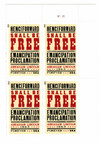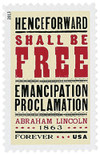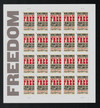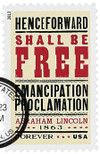
# 4721 - 2013 First-Class Forever Stamp - The Emancipation Proclamation
U.S. # 4721
2013 45¢ Emancipation Proclamation
Civil Rights Set
In the summer of 1862, the Confederates scored one victory after another. President Lincoln believed freeing slaves would weaken the South by greatly reducing its labor force. He prepared a proclamation that would free slaves in the Rebel states, but needed a Union victory to win support in the North. That chance came in September, when Northern forces stopped a Confederate invasion at Antietam, Maryland.
Within weeks, Commander-in-Chief Lincoln gave the Rebel states the choice to rejoin the Union before the new year or their slaves “henceforward shall be free.” The focus of the Civil War changed from restoring the Union to ending slavery.
On the first day of 1863, Lincoln issued his Emancipation Proclamation. The order only applied to slaves in Confederate states, but thousands of black refugees, or “contrabands of war,” at Union-held forts in the South celebrated their liberty. Young black men tasting freedom for the first time joined the U.S. Army and Navy in its fight to restore the Union and grant liberty to those still in bondage.
Lincoln’s proclamation had no effect on the daily life of many slaves. Their freedom came two years later, when the 13th Amendment was ratified, ensuring “slavery nor involuntary servitude” would never again “exist within the United States.”
To achieve its classic look, Hatch Show Print of Nashville, Tennessee, one of the oldest working letterpress print shops in the country, printed large-scale versions of the design.
The U.S. Postal Service asked New York-based designer Gail Anderson to design the stamp, and she jumped at the chance. "The biggest and smallest thing I've ever done!" she said.
In October of 2018, Anderson received the Lifetime Achievement National Design Award of her remarkable 30-year career designing everything from theater posters to Rolling Stone covers. The awards, bestowed by Cooper Hewitt, Smithsonian Design Museum, recognize leaders in design who demonstrate excellence, innovation and public impact in their work.
Value: 45¢ first class letter rate
Issued: January 1, 2013 – 150th anniversary of President Lincoln issuing the order
First Day City: Washington, D.C.
Type of Stamp: Commemorative
Printed by: Avery Dennison
Method: Photogravure printing in sheets of 200, with 10 panes of 20
Perforation: Serpentine Die Cut 11
Self-Adhesive
Quantity Printed: 55,000,000 stamps (over two print runs)
The First Juneteenth
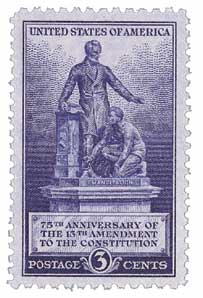
On June 19, 1865, slaves in Galveston, Texas, were finally informed of their freedom by the Emancipation Proclamation (issued two years prior). The day the last American slaves were freed has become a holiday celebrated officially in 45 states.
In the summer of 1862, the Confederates scored one victory after another. President Lincoln believed freeing slaves would weaken the South by greatly reducing its labor force. He prepared a proclamation that would free slaves in the Rebel states, but needed a Union victory to win support in the North. That chance came in September, when Northern forces stopped a Confederate invasion at Antietam, Maryland.
Within weeks, Commander-in-Chief Lincoln gave the Rebel states an ultimatum: rejoin the Union before the new year or their slaves “henceforward shall be free.” The focus of the Civil War changed from restoring the Union to ending slavery.
U.S. # 4721
2013 45¢ Emancipation Proclamation
Civil Rights Set
In the summer of 1862, the Confederates scored one victory after another. President Lincoln believed freeing slaves would weaken the South by greatly reducing its labor force. He prepared a proclamation that would free slaves in the Rebel states, but needed a Union victory to win support in the North. That chance came in September, when Northern forces stopped a Confederate invasion at Antietam, Maryland.
Within weeks, Commander-in-Chief Lincoln gave the Rebel states the choice to rejoin the Union before the new year or their slaves “henceforward shall be free.” The focus of the Civil War changed from restoring the Union to ending slavery.
On the first day of 1863, Lincoln issued his Emancipation Proclamation. The order only applied to slaves in Confederate states, but thousands of black refugees, or “contrabands of war,” at Union-held forts in the South celebrated their liberty. Young black men tasting freedom for the first time joined the U.S. Army and Navy in its fight to restore the Union and grant liberty to those still in bondage.
Lincoln’s proclamation had no effect on the daily life of many slaves. Their freedom came two years later, when the 13th Amendment was ratified, ensuring “slavery nor involuntary servitude” would never again “exist within the United States.”
To achieve its classic look, Hatch Show Print of Nashville, Tennessee, one of the oldest working letterpress print shops in the country, printed large-scale versions of the design.
The U.S. Postal Service asked New York-based designer Gail Anderson to design the stamp, and she jumped at the chance. "The biggest and smallest thing I've ever done!" she said.
In October of 2018, Anderson received the Lifetime Achievement National Design Award of her remarkable 30-year career designing everything from theater posters to Rolling Stone covers. The awards, bestowed by Cooper Hewitt, Smithsonian Design Museum, recognize leaders in design who demonstrate excellence, innovation and public impact in their work.
Value: 45¢ first class letter rate
Issued: January 1, 2013 – 150th anniversary of President Lincoln issuing the order
First Day City: Washington, D.C.
Type of Stamp: Commemorative
Printed by: Avery Dennison
Method: Photogravure printing in sheets of 200, with 10 panes of 20
Perforation: Serpentine Die Cut 11
Self-Adhesive
Quantity Printed: 55,000,000 stamps (over two print runs)
The First Juneteenth

On June 19, 1865, slaves in Galveston, Texas, were finally informed of their freedom by the Emancipation Proclamation (issued two years prior). The day the last American slaves were freed has become a holiday celebrated officially in 45 states.
In the summer of 1862, the Confederates scored one victory after another. President Lincoln believed freeing slaves would weaken the South by greatly reducing its labor force. He prepared a proclamation that would free slaves in the Rebel states, but needed a Union victory to win support in the North. That chance came in September, when Northern forces stopped a Confederate invasion at Antietam, Maryland.
Within weeks, Commander-in-Chief Lincoln gave the Rebel states an ultimatum: rejoin the Union before the new year or their slaves “henceforward shall be free.” The focus of the Civil War changed from restoring the Union to ending slavery.








